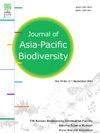Melissopalynological investigation of Tetragonula sapiens honey from Lombok Island, Indonesia
IF 0.7
Q4 BIODIVERSITY CONSERVATION
引用次数: 0
Abstract
This research aims to determine pollen diversity in Tetragonula sapiens stingless honey on Lombok Island, Indonesia. Analysis was carried out by melissopalynological investigation of nine samples of T. sapiens honey collected from nine locations with different altitudes (24-620 meters above sea level (MASL)). Standard methods for melissopalynological analysis carried out pollen extraction from honey. Based on melissopalynological investigations, it was found that eight honey samples were multifloral with the secondary pollen types including Artocarpus altilis, Arenga pinnata, Cocos nucifera, Muntingia calabura, Coffea sp., Ageratum conyzoides, and Galinsoga parviflora. Meanwhile, one honey sample obtained at Setiling village with 620 MASL of altitude was unifloral, with Arenga pinnata as the dominant pollen. The diversity of pollen in honey for several locations varies between 37 to 71 types of pollen. The results of this research may provide recommendations for improving the variety of nectar and pollen-producing plants suited for T. sapiens bees, especially for sustainable animal husbandry on Lombok Island. This research identified 147 types of pollen in honey belonging to 64 families. For lowland areas, A. altilis and C. nucifera are suitable. Meanwhile, M. calabura and Coffea sp. are suitable for midland areas, while A. pinnata and A. conyzoides are suitable for highland areas.
印度尼西亚龙目岛产智人四甲蜂蜂蜜的舌孢学调查
本研究旨在确定印度尼西亚龙目岛无刺智虎蜂蜂蜜的花粉多样性。对9个不同海拔(海拔24 ~ 620米)地点采集的9份蜜源进行了蜂蜜学调查分析。从蜂蜜中提取花粉进行花粉学分析的标准方法。结果表明,8份蜂蜜样品均为多花型,次生花粉类型包括Artocarpus altilis、Arenga pinnata、Cocos nucifera、Muntingia calabura、Coffea sp.、Ageratum conyzoides和Galinsoga parviflora。在海拔620 MASL的色梯岭村采集的1份蜂蜜为单花,优势花粉为凤尾莲。在一些地方,蜂蜜中的花粉种类在37到71种之间。本研究结果可为改善适合智人蜜蜂的花蜜和花粉植物品种,特别是龙目岛可持续畜牧业提供建议。本研究鉴定了蜂蜜中147种花粉,隶属于64科。在低地地区,适宜种植金菖蒲和金菖蒲。山楂和咖啡属植物适合中部地区生长,山楂和conyzoides属植物适合高原地区生长。
本文章由计算机程序翻译,如有差异,请以英文原文为准。
求助全文
约1分钟内获得全文
求助全文
来源期刊

Journal of Asia-Pacific Biodiversity
Agricultural and Biological Sciences-Insect Science
CiteScore
1.70
自引率
12.50%
发文量
94
审稿时长
27 days
期刊介绍:
The Journal of Asia-Pacific Biodiversity (previous title was Journal of Korean Nature) is an official journal of National Science Museum of Korea (NSMK) and Korea National Arboretum (KNA). The scope of journal is wide and multidisciplinary that publishes original research papers, review articles, as well as conceptual, technical and methodological papers on all aspects of biological diversity-its description, analysis and conservation, and its application by humankind. This wide and multidisciplinary journal aims to provide both scientists and practitioners in conservation theory, policy and management with comprehensive and applicable information. However, papers should not be submitted that deal with microorganisms, except in invited paper. Articles that are focused on the social and economical aspects of biodiversity will be normally not accepted.
 求助内容:
求助内容: 应助结果提醒方式:
应助结果提醒方式:


